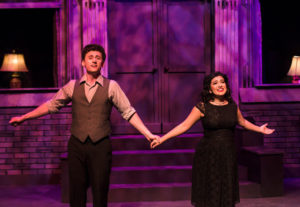
Arizona State University 2019-20 Review: Street Scene
Kurt Weill’s Unique Work Comes to Formidable Life
By Maria Nockin(Credit: Sam, Mason McDermaid, and Rose, Jasmine Rodriguez)
On Feb. 28, 2020, Arizona State University’s Music Theatre and Opera Department presented Kurt Weill’s “Street Scene” at the Evelyn Smith Theater. Weill composed “Street Scene,” to a libretto by Elmer Rice and Langston Hughes, after arriving in the United States and the results were very different from the works he wrote in Germany. Musically, its numbers run the gamut of styles from Puccini to 1940’s jazz. Weill described Street Scene” as an American opera despite its spoken passages. His music may show its European roots, but the text reflects specific American problems of the 40s, some of which have not been completely ameliorated today. Music Director Brian DeMaris led the orchestra of 28 players in a lucid rendition of this many-styled and dramatically fascinating piece.
The Production
“Street Scene” premiered in Philadelphia in 1946 and began a run on Broadway the following year. The ASU production, directed by Patrick Hansen, was a co-production with Canada’s McGill University. Scenic designer Alfredo Escarcega’s set featured a front staircase leading to a three-story tenement building with a large open window for each of the resident families.
Hansen presented Rice’s story as a realistic 48-hour snippet of life in a Manhattan lower East Side slum. There, most resident families, immigrant and native, were dependent on the paycheck brought home by the father and, as the only breadwinner, he sometimes ruled his wife and children with an iron hand. One elder character, Abraham Kaplan, portrayed by Victor Mercado, seemed to be Weill himself as he expressed his leftwing views about social and economic inequality along with his wish for revolution in the future.
Hansen brought out both humor and pathos in his characters’ stories. From the beginning, he set up the background for the dramatic crime of passion that changes the lives of those involved with the Maurrant family. Life continued, however, and the crime was forgotten as soon as possible by the neighbors.
Choreographer Mary Corsaro added a delightful Jitterbug dance for Kade Bailey as Dick McGann and Greta Perlmutter as Mae Jones. Sharon Jones’s softly printed dresses and neutral colored, double breasted suits placed the opera’s action firmly in its stated time period. Unfortunately, a few abrupt changes in Supervisor Gerard Willow’s lighting intruded on the action.
An Ensemble Cast
After a short and rather dissonant overture that portended varied styles of music, a trio of resident women, Madison Boyer as Greta Fiorentino, Molly Cox as Olga Olsen, and Mary Ott as Emma Jones opened the stage picture as they sang of the heat in humid New York during the era before air conditioning.
Darius Taylor as Henry Davis, the janitor, entered with a load of garbage singing ‘I’ve Got a Marble and a Star,’ perhaps symbolizing his youth and his dream of escaping the drudgery of his menial job and tenement life. Taylor sang with a bronze-tinged baritone voice and announced himself as a singer on the rise. Samantha Dávalos as Anna Maurant joined the ensemble and sang the soprano aria ‘Somehow I Never Could Believe’ with polished dramatic tones.
Dávalos and Jasmine Rodriguez who sang her daughter, Rose, were the divas of the evening. Both have large, exciting voices with well-knit registers. At the end of her second aria, Dávalos executed an excellent messa di voce that showed significant technique. When Benjamin Krutsch as the self-important Lippo Fiorentino arrived with some ice cream to help his neighbors endure the heat, they let it melt while they performed a charming sextet. As Rose, Rodriguez arrived with her harassing and dangerously seductive boss, Harry Easter, sung by Thomas Hastings. She established her character’s point of view when she sang the poignant ‘What Good Would the Moon Be?’ The first act closed with the aforementioned Jitterbug number and a reprise of the Janitor’s ‘I Got a Marble and a Star.”
The second act opened with an amusing game of ‘Catch Me if You Can’ but the mood changed completely when Mauricio Perusquia as Frank Maurrant appeared. He sang ‘There’ll be Trouble,’ threatening his wife and daughter for not obeying his old-fashioned rules. That afternoon, he came home unexpectedly early, caught his wife, Anna, with her lover, and shot both of them, only to later proclaim that he loved Anna. Perusquia’s Frank was a complex portrait of a man who could not deal with social change.
After the murder, Rose, who had earlier accepted Sam Kaplan’s plan to elope at some time in the future, told him circumstances had changed and she would leave alone. Mason McDermaid was a credible Sam but this is modern opera and the lyrical tones of ‘Lonely House’ did not win Rose’s love. The show ended with the same trio of ladies we saw at the opening decrying the heat. The Maurrants have moved but the mood at the building was much the same as it has been the day before the murder.
“Street Scene” is an excellent choice for a university opera/music theatre program because it employs more than 40 individual characters. Although not all of them were completely developed in the libretto, ASU’s students made them come alive.


